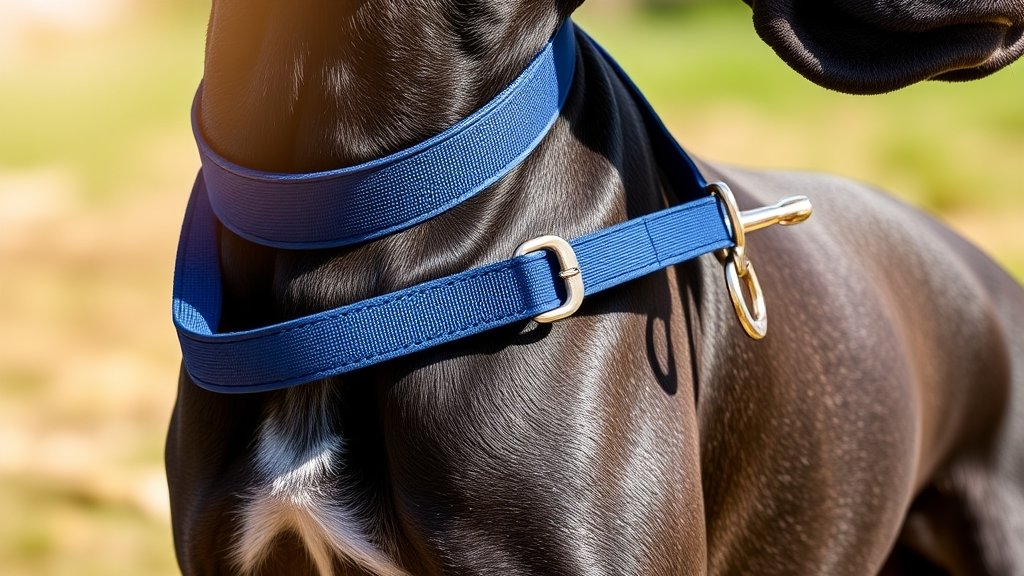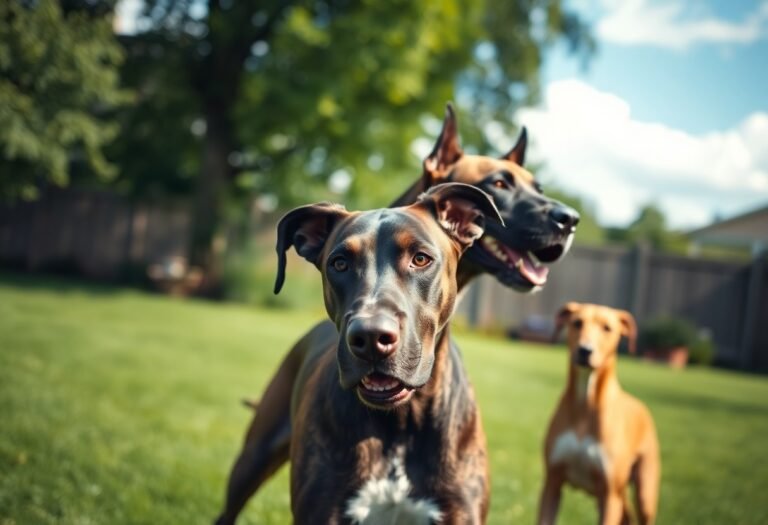Best Dog Leash for a Great Dane
Best Leash for Great Dane
Hey there, fellow humans! It’s me, your friendly neighborhood Great Dane, and I need to talk to you about something super important – my leash!
Trust me, I’ve accidentally snapped a few cheap leashes while chasing squirrels (sorry, Mom!). When you’re picking out my walking gear, you’ve got to think BIG – just like me!
First things first – make it STRONG! I’m not trying to escape or anything, but sometimes I see a fascinating smell and, well, these paws have a mind of their own. Get me something made of tough nylon or leather that won’t break when I suddenly spot my arch-nemesis: the neighbor’s cat.
And please, PLEASE get yourself a padded handle! Your hands are way smaller than mine (obviously), and when I get excited about walkies, I don’t want to give you rope burn. That would make me feel terrible, and then I’d have to provide you with extra slobbery kisses to make up for it.
Oh, and here’s a pro tip from someone who’s tried every walking setup imaginable – think about whether you want me wearing a collar or harness. I personally vote for whatever keeps me comfortable while I strut my stuff around the neighborhood.
The bottom line? Get good gear so we can both enjoy our adventures together!
Importance of Choosing the Right Leash for Great Danes
First off, let’s talk about length. I need enough room to sniff that amazing fire hydrant without yanking your arm off! But not so much that I can chase every squirrel I see (though they’re pretty tempting). Trust me, you don’t want me dragging you across the park because I spotted an exciting stick.
Now, about width – this is huge for us big dogs. A skinny leash feels like wearing a tight collar all the time. Ouch! A wider leash is like the difference between flip-flops and comfy sneakers. It spreads out the pressure so I’m not uncomfortable when I get excited about meeting new friends.
Materials matter, too, people! You need something strong enough to handle my enthusiasm when I see another dog. I might be friendly, but I’m also 150 pounds of pure excitement. Get something with a good grip because your hands will thank you when I suddenly decide that leaf absolutely must be investigated right now.
The right leash makes our walks awesome for both of us. I get to explore and have fun, and you get to keep control without wrestling a small horse. Plus, when we’re both happy and comfortable, our walks become the best part of both our days! Also, remember that high-quality leashes enhance safety and comfort for my big frame, so choose wisely!
Harness Vs Collar: Which Is Better for Your Great Dane?
Woof! Let me tell you about the great collar versus harness debate from a Great Dane’s perspective. Trust me, I’ve worn both, and I have some strong opinions!
As a gentle giant who’s been dragged to the pet store more times than I can count, I know a thing or two about what goes around my neck (or chest). My humans seem to think this is a big decision, but honestly, I want whatever lets me sniff the most fire hydrants.
| Feature | Why Collars Rock (From My POV) |
|---|---|
| Easy to use | Humans can’t mess this up – even on Monday mornings |
| Identification | Shows everyone I’m not a small horse |
| Cost-effective | More leftover money for treats! |
| Minimalist style | I look like a sophisticated doggo |
| Feature | Why Harnesses Are Pawsome |
| Comfort | My neck doesn’t feel like it’s in a wrestling match |
| Control | Harder for me to drag my human to every squirrel |
| Security | Can’t slip out when I see the mailman |
| Stability | Pressure spreads out so I don’t choke myself chasing cats |
Here’s the thing – I’m a four-legged freight train. When I see something exciting (which is everything), I tend to forget my size. A collar works fine when I’m being my usual calm, majestic self. But when that neighborhood cat shows up? Well, let’s say my human appreciates the harness on those days.
My advice? Get both! Use the collar for casual walks when I’m feeling chill, and break out the harness when we’re going somewhere with lots of distractions. Your arm will thank you, and I’ll still get to investigate all the important smells. Plus, using a harness can help manage my early socialization and ensure I grow up to be a well-mannered giant!
Essential Features for Great Dane Leashes
First things first – I’m not exactly a tiny Chihuahua. I’m more like a small horse with a wagging tail. That means my leash needs to be tough enough to handle my excitement when I spot a squirrel. Trust me, when I see one of those furry little troublemakers, I go from gentle giant to “MUST CHASE NOW!” in about two seconds.
My humans learned this the hard way when our first flimsy leash snapped and I took off after Mr. Fluffy Tail.
Now, about those handles. My humans’ hands get pretty tired holding onto me, especially when I decide to practice my sled dog impression. Padded handles are a lifesaver – literally. Without them, my poor humans would probably have rope burns by the time we get home.
Plus, happy humans mean longer walks, and longer walks mean more opportunities to sniff interesting things and mark my territory.
The length thing is super important, too. Sometimes I want to investigate that fascinating smell three feet away (it could be another dog’s message!), and sometimes my humans need me close when we’re walking past the neighbor’s yappy little dogs who think they’re tougher than me.
Adjustable leashes give us both what we need.
And those shiny reflective strips? Pure genius! When we go out for evening potty breaks, cars can see my magnificent self coming down the sidewalk.
Safety first – I’ve got too much living to do to become roadkill. Also, choosing a leash with heavy-duty materials is essential for managing the strength of a Great Dane during walks.
Training Tips to Enhance Leash Control
Although we all love our daily walks, mastering leash control can transform those outings from chaotic adventures to enjoyable strolls. As a Great Dane, I’ve learned a thing or two about leash training that I’d love to share with my fellow four-legged friends!
First up – positive reinforcement is amazing! When I walk calmly beside my human instead of dragging them down the street like a sled dog, they give me treats and belly rubs. Trust me, those snacks are way better than whatever squirrel I was chasing.
Positive reinforcement makes leash training fun! Treats and belly rubs are way more rewarding than chasing squirrels.
Plus, my human seems much happier when they’re not being yanked around like a rag doll.
Consistency really works, even though I sometimes pretend I don’t understand what “heel” means. Those short training sessions are perfect because my attention span isn’t exactly legendary.
Five minutes of good walking beats an hour of me pulling my human toward every interesting smell.
Here’s my favorite trick: when I get too excited and start pulling, my human just stops walking. At first, I thought they were broken! But I quickly figured out that coming back to their side means the walk continues.
It’s like a fun game where I get to be the smart one. To ensure positive experiences during our walks, my human is also mindful of using proper leash equipment that can enhance our training sessions.
With some patience and practice, our walks went from tug-of-war matches to peaceful neighborhood tours. Now my human and I both enjoy our adventures together!
Durability and Maintenance for Long-lasting Leashes
When my humans pick out a leash for me, they had better think about how tough it needs to be! My leash needs to handle my excitement when I see a squirrel or smell something amazing on our walks.
My humans need to choose strong materials that won’t snap when I suddenly decide to chase that interesting leaf blowing in the wind. They should check my leash regularly for any worn spots or fraying. Trust me, I don’t want my leash breaking right when I’m trying to say hello to that friendly dog across the street!
If they find any weak areas, they should fix them right away or get a new leash. A good, strong leash means we can enjoy our walks without any surprises. Plus, it keeps me safe and my humans happy.
And when my humans are happy, I get more treats and belly rubs!
The best part is that a well-maintained leash lasts longer, which means more adventures together. Whether we’re strolling through the neighborhood or exploring new trails, I want my leash to be as ready for fun as I am! Additionally, a reliable leash is crucial for maintaining the calm behavior that Great Danes are known for during our outings.
Material Selection Importance
First off, let’s talk materials because not all leashes are created equal, especially when you’re dealing with a gentle giant like me. You’ve got three main choices: nylon, leather, and something called biothane.
Nylon is pretty cool – it’s light so it won’t weigh down my already massive neck, but it’s also tough enough to handle my enthusiasm when I spot a squirrel. Just saying, squirrels are very exciting!
Leather looks fancy and feels nice, which is perfect since I’m a sophisticated pooch. Plus, it gets softer over time, much like how I become more comfortable with my humans the longer we’re together.
Now biothane – this stuff is like the superhero of leash materials! It’s waterproof, which is awesome because I love puddles, mud, and anything that makes my humans groan. It’s also super easy to clean, so when I decide to roll in something questionable, you can just hose it off.
Here’s the thing about length – longer leashes give me more room to explore and sniff all the good smells, but make sure whatever material you pick can handle my size. I’m not trying to drag you down the street, but sometimes my legs just get excited and forget how big I am!
The bottom line? Please don’t go cheap on my leash! A good quality one keeps both of us safe and happy, especially since durability and safety in dog toys are just as crucial for leashes to ensure they withstand my powerful pulls. Trust your Great Dane on this one – we know what works!
Regular Inspection Practices
Keeping My Leash in Tip-Top Shape (A Great Dane’s Guide)
My humans have learned the hard way that they need to check my leash regularly. Trust me, when a 150-pound Great Dane spots a squirrel, you want to make sure that leash is rock solid! They inspect my leash at least once a month, looking for any frayed spots, cracks, or rusty parts on the metal clips.
I try to help with these inspections by giving my leash a good sniff test. Sometimes I even give it a little tug to make sure it’s still strong enough to handle my enthusiasm when I see my doggy friends at the park. My humans don’t always appreciate my “help,” but hey, quality control is important!
If they find any damage during our monthly check-ups, they replace my leash right away. I’ve learned that a broken leash means no walks, and nobody wants that!
Plus, keeping me safe makes everyone happy – especially when I get excited and forget just how big and strong I am. A sturdy leash means more adventures together, and that’s what life is all about!
Additionally, durability and strength are crucial for withstanding the power of Great Danes, ensuring that our leashes can handle all our playful antics!
Reinforcement of Weak Spots
Making My Leash Super Strong (Because I’m Super Strong Too!)
My humans learned this the hard way when I spotted a squirrel last Tuesday. One second, I was walking nicely, the next second, I was chasing Mr. Fluffy Tail, and my leash went SNAP! Oops.
Now, my family constantly checks my leash for weak spots, looking out for when I might accidentally break free again. Smart humans! But the real magic happens when they make those weak spots stronger. That’s how they keep me safe (and keep me from chasing every interesting smell in the neighborhood). Plus, they know that a well-maintained leash is essential for my health and safety needs during our walks.
| What Breaks on My Leash | How My Humans Fix It |
|---|---|
| Metal clip thingy | Get the heavy-duty kind that won’t break when I see cats |
| The sewn parts | Stitch it twice because I’m twice as strong as regular dogs |
| Where they hold on | Add fluffy padding so their hands don’t hurt when I pull |
| The leash itself | Pick fabric that won’t rip when I get excited |
Trust me, when you weigh as much as a small pony, you want a leash that can handle your enthusiasm! My humans learned that keeping my leash strong means we both stay happy and safe during our adventures.
Traveling With Your Great Dane: Leash Considerations
My humans learned the hard way always to pack an extra leash. Remember that time I decided to taste-test my leash during our road trip? Yeah, leather isn’t as delicious as it smells, but I still managed to chew right through it. Now they always bring a backup – smart humans!
My humans learned the hard way—always pack an extra leash! Chewing through mine was a tasty mistake!
Storage is super important too. My humans use these neat little bags to keep all my travel gear organized. No more digging through suitcases while I’m doing my “I really need to go potty” dance in the hotel parking lot. Everything’s right there when they need it.
The best part about good leash planning? More adventures for me! When my humans are prepared, we can explore new places without stress.
And between you and me, happy humans mean more treats and belly rubs for this good boy. Win-win!
Final Thoughts
Woof! Listen up, humans – picking the right leash for us Great Danes is super important. Trust me, I know what I’m talking about here! There are tons of leashes out there, and I bet you’re feeling pretty confused about which one to get. But hey, once you find the perfect one for me, you’re going to feel like a total champion!
Don’t forget – I’m an awesome dog and I deserve the coolest gear around. Are you ready to make the right choice for your giant buddy? Once you get me hooked up with an amazing leash, we can go on the best adventures ever! We’ll make memories that’ll last forever, and I promise to only drag you toward interesting smells… most of the time. After all, life’s way more fun when you’ve got a gentle giant like me by your side!
References
- https://www.youtube.com/watch?v=ZvbWcDcG7vo
- https://greatdanecare.com/great-dane-leash-training-guide/
- https://havedanewilltravel.com/leashes-for-traveling-with-great-danes/
- https://havedanewilltravel.com/best-collar-for-safely-walking-a-great-dane/
- https://www.great-dane-dog-breed-store.com/dog-leashdog-leads-c-5/safe-control-retractable-neon-nylon-great-dane-leash-with-reliable-braking-system–size-medium-p-855.html







4 Comments